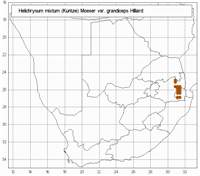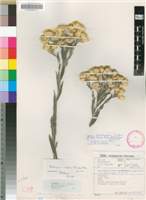Origin of name:
mixtus/ -a/ -us = mixed grandiceps = large headed
Diagnostic characters:
Large headsPale yellow bractsOpen branched inflorescence
Description:
Perennial herb, stock stout, woody, flowering stems several from the crown, simple, erect to c. 450 mm, thinly greyish-felted, leafy throughout. Radical leaves rosetted, c. 40�100 (�190) x 10�20 (�40) mm, elliptic, elliptic-lanceolate or oblanceolate, apex acute or subacute, slightly narrowed to a broad clasping base, both surfaces thinly grey-woolly; cauline leaves much smaller, diminishing in size upwards, lanceolate to linear-lanceolate, acute to acuminate, base broad, clasping, shortly decurrent, both surfaces thinly grey-woolly. Heads homogamous, campanulate, 12�15 mm long, several in a congested or open corymbose panicle. Involucral bracts in c. 6�8 series, subequal or slightly graded, loosely imbricate, inner slightly exceeding flowers, radiating, glossy, bright yellow, all acute or subacute or sometimes inner obtuse. Receptacle with fimbrils exceeding ovaries. Flowers 95�155, yellow. Achenes 1 mm long, barrel-shaped, glabrous. Pappus bristles many, scabrid, tips barbellate, bases cohering strongly by patent cilia.
Flowers in December, January and February, mostly earlier than var. mixtum in Mpumalanga.
Distribution:
Recorded from Graskop and Mac Mac South through western Swaziland to Piet Retief; growing on grassy mountain slopes.
Grassland and Savanna Biomes.
Notes:
H. mixtum is aptly named, for it combines the foliage of H. cephaloideum with the loose inflorescence and acute involucral bracts of H. longifolium, as Kuntze himself pointed out, and it is not always possible to place specimens with certainty. In the Cape, despite the inner involucral bracts often being as obtuse as in H. cephaloideum, there is no difficulty in distinguishing H. mixtum with heads consistently larger than those of H. cephaloideum and loosely arranged. In KwaZulu-Natal and Mpumalanga, however, the situation is not so clear cut. In KwaZulu-Natal, it is often difficult to decide whether a specimen is better placed as H. mixtum or H. cephaloideum or even H. longifolium. As suggested before (Hilliard l.c.), this may be due to crossing, or speciation in this whole difficult group may be incomplete. In the northern provinces, the situation is complicated by the presence of a plant that differs from H. mixtum in its larger heads with less glossy involucral bracts, and in its earlier flowering time. For convenience, it is accorded varietal rank, but experimental work on the whole group is highly desirable.
Distinguished from typical H. mixtum by its larger heads (12�15 mm long, containing 95�155 flowers) with involucral bracts generally less glossy. Specimens with heads not fully expanded may be difficult to place.
Taxonomy:
Literature:
Helichrysum mixtum (O. Kuntze) Moeser var. grandiceps Hilliard in Flora of southern Africa 33,7 (2): 253 (1983).
Type:
Mpumalanga, Barberton, Dec. 1916, Pott 5408 (PRE, holo.).
Synonym(s):
Vouchers:
Galpin 1293 (PRE); Hutchinson 2417 (PRE); Liebenberg 2430 (PRE); Muller 2018 (PRE); De Villiers 95 (PRE); Smuts & Gillett 2260 (PRE); Werdermann & Oberdieck 2115 (PRE); Irvine 13 (PRE); Sidey 3348 (PRE); Compton 27357 (PRE); Compton 32487 (PRE); Rogers 11460 (PRE); Prosser 1953 (PRE); Burtt Davy 3008 (PRE); Compton 26424 (PRE).
